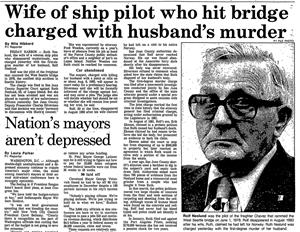At 2:38 a.m. on June 11, 1978, the freighter Chavez rams the West Seattle Bridge over the Duwamish West Waterway, thereby closing it to automobile traffic for the next six years.
The Chavez was 550 feet long and carrying 20,000 tons of gypsum under the command of 80-year-old Puget Sound Pilot Rolf Neslund (1897-1980) and its master, Gojko Gospodnetic, when, just before dawn, it struck the east end of the bridge. A Coast Guard board of inquiry found both officers negligent. Neslund retired two weeks after the accident. Gospodnetic, a Yugoslav national, was fired.
Two years later, Neslund's wife murdered him on Lopez Island, later claiming that he had returned to Norway. Although no trace of the body was ever found, she was convicted of the crime and died in prison.
The Silver Lining
The accident had one positive result: It ended years of debate over a new West Seattle Bridge, particularly a high bridge to accommodate Port of Seattle plans for expanded use of the Duwamish Waterway. The previous effort to build a bridge collapsed in 1975 amid a kickback scandal that sent the City Engineer to prison.
After the accident, Mayor Charles Royer (b. 1939) and City Councilmember Jeanette Williams (1914-2008) enlisted the aid of U.S. Senator Warren G. Magnuson (1905-1989) to secure federal funds and the participation of the U.S. Army Corps of Engineers as project manager for the high-level bridge. The new span was dedicated on July 14, 1984, at a cost of $150 million including $60 million in federal money. A new pivot-wing bridge later replaced the original bascule bridge.

